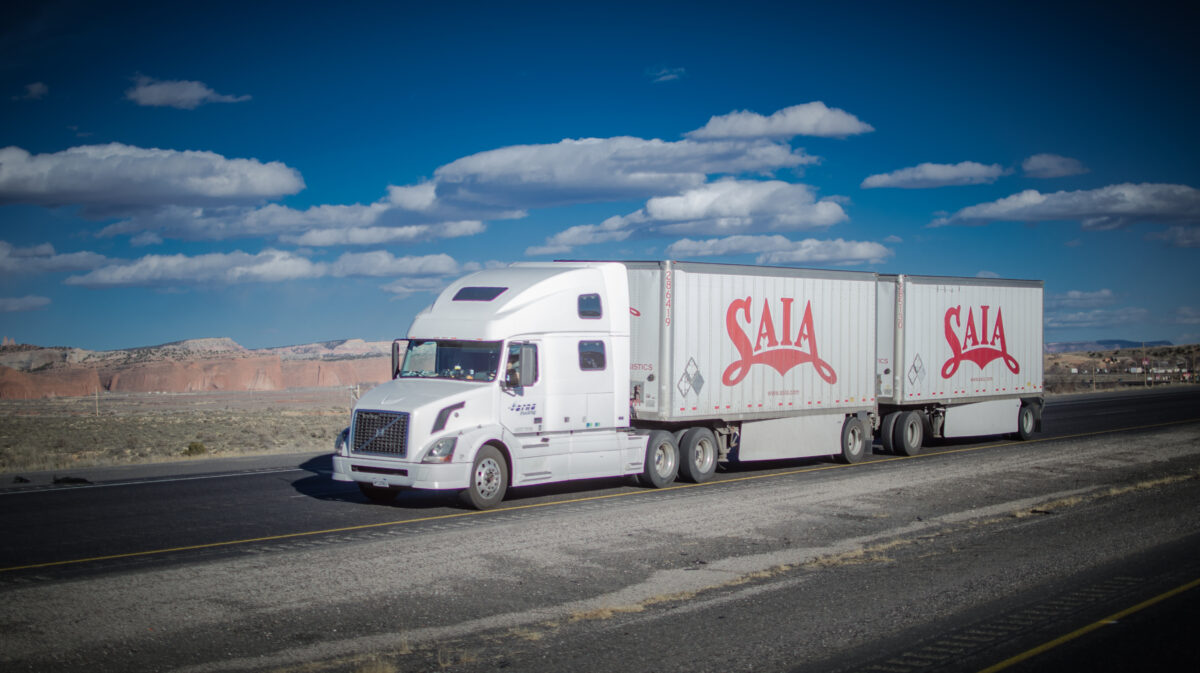With Saia having opened seven terminals in 2021, and with plans to add another 10 to 15 in the coming year, CEO Fritz Holzgrefe took the opportunity of his company’s quarterly earnings call with analysts Wednesday to talk about the challenges and benefits of building that new capacity.
The earnings call came a few hours after Saia (NASDAQ: SAIA) released its quarterly earnings that showed its operating ratio had strengthened to 84.2% in the fourth quarter from 89.4% a year earlier, its revenue per hundredweight excluding fuel improved 14% to $18.89 from the fourth quarter of 2020, and total revenue for the company rose 29.5% from the final quarter of 2020 and 25.5% for the full year.
Holzgrefe also said during the call that in addition to the new terminals, about 10 existing terminals would be relocated to sites it considers “better positioned.”
In response to a question from an analyst about the costs of opening a new terminal, Holzgrefe said Saia has opened enough terminals that “we feel we know how to do this.” He referred to the “cadence” of when to begin recruiting, how to onboard staff members and developing a “pipeline of leadership” that can operate a new terminal.
How fast does a new terminal get to the company’s operating ratio level? Holzgrefe described it as “months rather than years.” But he didn’t want to get too specific, saying he wasn’t attempting to be “evasive” on the question. “It is just tough to say it is eight months, seven months, six months, I don’t know,” according to a transcript of the earnings call provided by Seeking Alpha.
But as CFO Doug Col noted on the call, Saia had a 470 basis point improvement in its OR for the year, even as it opened seven new terminals and took on those costs. “So I think that’s where we gain confidence and part of the competency issue,” he said.
While Saia is seeking new sites for its terminals, it’s competing against other LTL companies as well as supply chain activities like warehouses. It is also competing for employees and Holzgrefe said that if Saia is in line on pay and benefits with industry standards, “you differentiate … around quality and place to work. And the growth profile certainly helps kind of drive that.”
Holzgrefe also made an apparent reference to the closure of Central Freight Lines, noting that even as the company needs to compete with others for space, “there also are some that are exiting, and we saw some of that just in the quarter. That creates available real estate terminals that we could potentially pursue.” Without referring to Central Freight by name, he said of the opportunities created by its closure, “Certainly those are assets that are of interest to us, and there could be others down the road.”
Saia is not going into the new developments at a pace that exceeds the ability to get equipment into the new terminals, Holzgrefe said. Difficulty that OEMs have in delivering equipment was a factor in 2021, he said, and “right now we’ve kind of built our plan around the idea of what we think we’ll get from them, not necessarily what they have represented they would provide to us in terms of timing.” As a result, there is a “little bit of a cushion” and delivery delays would not be a “hindrance,” Holzgrefe added.
Holzgrefe also said he believes the addition of 10 to 15 terminals will be repeated in 2023.
On other issues, CFO Col said contract renewals have been at double-digit percentages for three consecutive quarters and were high single digits prior to that. He put a specific number of 10.4% on the size of renewables in the fourth quarter.
Year-on-year comparisons may be challenged going forward, Col said, because they will be against the strong levels recorded in 2020. “But I think what we’re seeing around the environment with the [general rate increases] is pretty good indication to us that pricing is going to be another opportunity this year,” he said.
Saia recently implemented a 7.5% increase in its GRI. That serves as a base point for pricing negotiations, with the end number possibly going higher or lower, though higher has been the prevailing direction in the market. “Our GRI is an indication of what we think is going to be achievable for the year,” he said.
But the actual size of the increases is being reached in a “very targeted way to help us work on [product] mix,” Col said. “Mix has been a big part of our own story, finding the freight that works for us, whether it’s the right weight break, or the right length of haul, whatever the case may be,” he said. Adjustments to the base GRI are “more targeted.”
The earnings call also provided the opportunity for a one-month update. CFO Doug Col said that after a December in which shipments per workday were up 4.8% and tonnage was up 13.7%, January figures were 1.3% for shipments and 7.5% on tonnage. He described the January numbers as “pretty good.”
With Saia’s OR having improved 470 bps for the full year, to 85.4% from 90.1%, Holzgrefe was asked about further improvement in the company’s margin going forward. He said that a further improvement of 150 to 200 bps was “very achievable.” But in the short term, Col said given the normal tough challenges in the first quarter, Saia was holding to its forecast for a 50 bps deterioration in OR from the fourth-quarter figure of 84.2%.
The FREIGHTWAVES TOP 500 For-Hire Carriers list includes Saia Inc. (No. 16).
More articles by John Kingston
Highly profitable Heartland draws concern about its revenue from Barclays
Drivers tell WorkHound: onboarding goes a long way in retention
2022 may be pivotal year for California’s green rules for trucks










